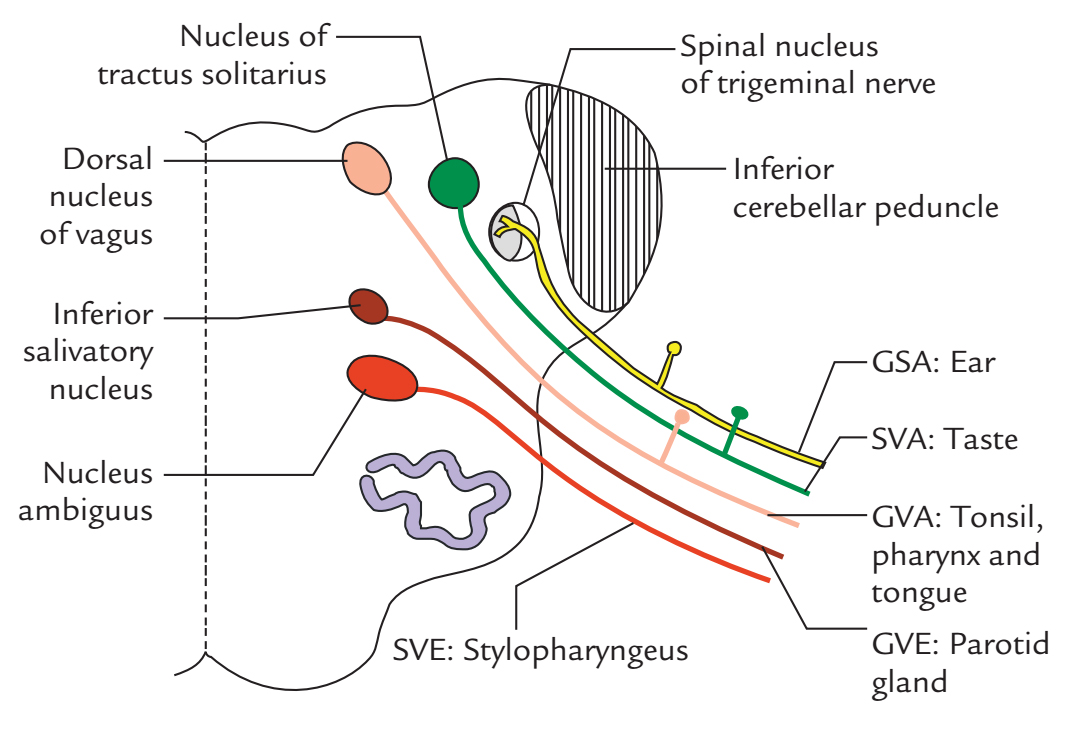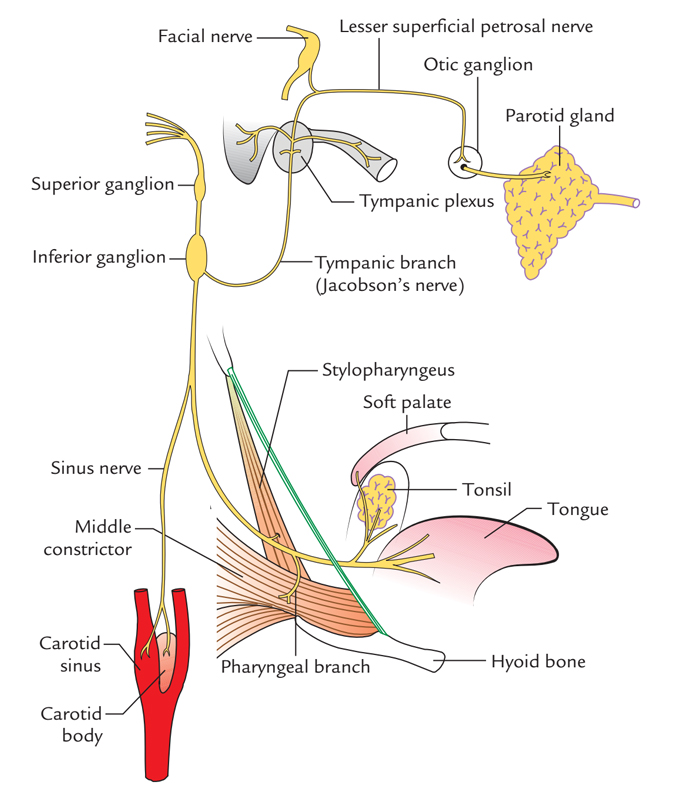Makindo Medical Notes"One small step for man, one large step for Makindo" |
|
|---|---|
| Download all this content in the Apps now Android App and Apple iPhone/Pad App | |
| MEDICAL DISCLAIMER: The contents are under continuing development and improvements and despite all efforts may contain errors of omission or fact. This is not to be used for the assessment, diagnosis, or management of patients. It should not be regarded as medical advice by healthcare workers or laypeople. It is for educational purposes only. Please adhere to your local protocols. Use the BNF for drug information. If you are unwell please seek urgent healthcare advice. If you do not accept this then please do not use the website. Makindo Ltd. |
Glossopharyngeal Nerve (Cranial Nerve IX)
-
| About | Anaesthetics and Critical Care | Anatomy | Biochemistry | Cardiology | Clinical Cases | CompSci | Crib | Dermatology | Differentials | Drugs | ENT | Electrocardiogram | Embryology | Emergency Medicine | Endocrinology | Ethics | Foundation Doctors | Gastroenterology | General Information | General Practice | Genetics | Geriatric Medicine | Guidelines | Haematology | Hepatology | Immunology | Infectious Diseases | Infographic | Investigations | Lists | Microbiology | Miscellaneous | Nephrology | Neuroanatomy | Neurology | Nutrition | OSCE | Obstetrics Gynaecology | Oncology | Ophthalmology | Oral Medicine and Dentistry | Paediatrics | Palliative | Pathology | Pharmacology | Physiology | Procedures | Psychiatry | Radiology | Respiratory | Resuscitation | Rheumatology | Statistics and Research | Stroke | Surgery | Toxicology | Trauma and Orthopaedics | Twitter | Urology
Related Subjects: |Olfactory Nerve |Optic Nerve |Oculomotor Nerve |Trochlear Nerve |Trigeminal Nerve |Abducent Nerve |Facial Nerve |Vestibulocochlear Nerve |Glossopharyngeal Nerve |Vagus Nerve |Accessory Nerve |Hypoglossal Nerve
Origin and Course
The glossopharyngeal nerve, also known as cranial nerve IX, is a mixed nerve that has both motor and sensory components. It plays a crucial role in taste, swallowing, and the regulation of blood pressure and respiration. The glossopharyngeal nerve originates in the medulla oblongata of the brainstem and follows a complex path to innervate various structures in the head and neck.
Lateral Medulla

Further journey

- Origin :
- Arises from the medulla oblongata, specifically from the nucleus ambiguus, the inferior salivatory nucleus, and the solitary nucleus.
- Emerges from the medulla oblongata as several rootlets that converge to form the nerve.
- Intracranial Course :
- Exits the brainstem and passes through the jugular foramen, along with the vagus and accessory nerves.
- Immediately after exiting the skull, the nerve gives off the tympanic nerve, which re-enters the temporal bone and participates in forming the tympanic plexus.
- Extracranial Course :
- Descends between the internal jugular vein and the internal carotid artery.
- Passes between the superior and middle pharyngeal constrictors to reach the pharynx and tongue.
Branches of the Glossopharyngeal Nerve
The glossopharyngeal nerve has several branches that innervate various structures in the head and neck.
- Tympanic Nerve :
- Provides sensory innervation to the middle ear and contributes to the tympanic plexus.
- Gives rise to the lesser petrosal nerve, which supplies parasympathetic fibers to the parotid gland.
- Carotid Sinus Nerve :
- Innervates the carotid sinus and carotid body, which are involved in regulating blood pressure and respiratory rate.
- Pharyngeal Branches :
- Contributes to the pharyngeal plexus, which innervates the muscles of the pharynx and soft palate.
- Stylopharyngeal Branch :
- Innervates the stylopharyngeus muscle, which helps elevate the pharynx during swallowing and speech.
- Tonsillar Branches :
- Provide sensory innervation to the palatine tonsils.
- Lingual Branch :
- Provides general and special sensory innervation (taste) to the posterior one-third of the tongue.
Functions of the Glossopharyngeal Nerve
- Sensory Functions :
- Taste sensation from the posterior one-third of the tongue.
- General sensory innervation to the posterior one-third of the tongue, pharynx, middle ear, and eustachian tube.
- Visceral sensory information from the carotid sinus and carotid body, which monitor blood pressure and blood chemistry.
- Motor Functions :
- Innervation of the stylopharyngeus muscle, aiding in swallowing.
- Parasympathetic Functions :
- Parasympathetic fibers to the parotid gland via the lesser petrosal nerve, stimulating saliva production.
Clinical Relevance
- Glossopharyngeal Neuralgia :
- Characterized by severe, sharp, shooting pain in the areas innervated by the glossopharyngeal nerve, such as the throat, tonsils, and tongue.
- Often triggered by swallowing, chewing, talking, or coughing.
- Lesions of the Glossopharyngeal Nerve :
- Can result from trauma, tumours, infections, or vascular compression.
- Symptoms include loss of taste sensation in the posterior one-third of the tongue, difficulty swallowing, and reduced salivation.
- Testing the Glossopharyngeal Nerve :
- Assessment includes testing the gag reflex, evaluating the taste on the posterior third of the tongue, and checking for swallowing difficulties.
Summary
The glossopharyngeal nerve (cranial nerve IX) is a mixed nerve that plays a vital role in taste, swallowing, and autonomic functions related to blood pressure and salivation. It originates in the medulla oblongata, exits the skull through the jugular foramen, and innervates various structures in the head and neck. Clinical conditions affecting the glossopharyngeal nerve include glossopharyngeal neuralgia and nerve lesions, which can lead to pain, loss of taste, and swallowing difficulties.